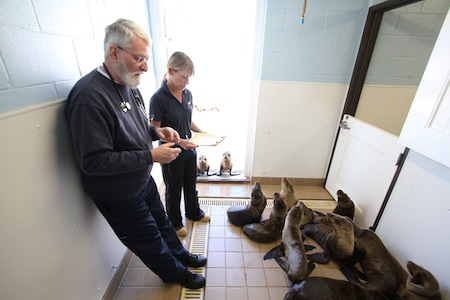
Nearly 130 stranded and starving sea lions are once again pushing recovery cages and pools to the maximum at the Pacific Marine Mammal Center in Laguna Canyon, the organization says. More than 1,900 sea lions have been stranded along California coasts since January, the highest number for any recorded year, according to the National Oceanic and Atmospheric Administration.
Lack of food, particularly high-fat and calorie-rich sardines is one reason cited by PMMC. Sardines are scarcer and mother sea lions are leaving their pups for longer periods to feed deeper and farther away, “stranding” their offspring, according to the report by PMMC. The sea mammal care center is the only organization in Orange County licensed to rescue and rehabilitate sick and injured sea lions, seals and, occasionally, dolphins between San Clemente and Seal Beach.
Inadequate quantities of fatty prey fish such as sardines and anchovies yield less

mother’s milk and cause the premature weaning of pups too young to fend for themselves, a NOAA report explains. Due to limited space and resources, animal rescue agencies are picking up only those pups with the greatest chance of survival, NOAA says.
When hundreds of sea lion pups were stranded along Orange County shores and dying from starvation in 2013, scientists weren’t ready to pinpoint the cause of the “unusual mortality event.” The causes are becoming clearer, with scientists pointing to an acidifying ocean, unusually warm water temperatures and depleted fish populations as suspected culprits for the current influx of emaciated sea lion pups.
“We are seeing unprecedented changes in the environment,” Toby Garfield, director of the Environmental Research Division at NOAA’s South West Fisheries Science Center, said in a statement.
Garfield cited unusually high coastal water and air temperatures over the last year. Climate and ecological indicators are “pointing toward lower primary productivity” of fish off California, Oregon and Washington coastlines. High mortality of sea lion pups in Southern California and seabirds on the Oregon and Washington coasts in recent months may be early signs of the shift, he said.
Ocean acidification due to carbon emissions from vehicles and industry is another contributing factor to unhealthy seas, and the National Marine Fisheries Service recently stated in a plan calling for the reduction of carbon emissions. The plan relates to efforts to save sea corals near Florida and in the Caribbean, a result of a settlement with the Center for Biological Diversity, which relies on litigation to protect threatened environments. The recovery plan identifies threats to plant and animal species, including climate change and ocean acidification.
“The clock is ticking to save these beautiful corals,” said Shaye Wolf, the Center’s climate science director, “so I’m happy to see there’s finally a concrete plan to move them toward recovery. The plan rightly recognizes that we’ll need to manage local threats like near-shore pollution, but also address complex global threats like climate change.”
The Pacific sardine population has plummeted by 90 percent since 2007 and continues to be fished, according to the Oceana foundation, dedicated to ocean advocacy and based in Washington, D.C. Sea lion pups aren’t the only ones suffering, said the foundation, citing a ripple effect that could extend through many species in the ocean ecosystem for years. Dead and emaciated shore birds are also being found, according to the Oceana report.
Fish fertility is dwindling due to exposure to manmade chemicals such as BPA used in plastic household products and EE2, a synthetic estrogen in oral contraceptives found in ocean environments downstream of wastewater treatment plants, according to a study released this past Tuesday by the U.S. Geological Survey and the University of Missouri.
As of Monday, 800 sea lion strandings so far this month were reported in central and southern California, according to NOAA. In February, 850 were reported, the highest number since 2004. Due to slower growth rates this year, sea lion pup mortalities are a greater concern than in previous years, NOAA reported.
Although weak, an El Nino current in California has brought in warmer waters than usual, the report continued. Historically, El Nino years have resulted in high numbers of marine mammal strandings, likely due to changes in available prey fish and increased physiologic stress on the animals, the report stated.
The first nationwide assessment for ocean acidification, published Monday in Nature Climate Change, shows the long-term economic risk from ocean acidification to coastal communities in 15 states. The assessment covers the Pacific Northwest, which depends on the nation’s approximately $1 billion shelled mollusk industry, which includes oysters, clams and mussels.
Rescue agencies warn beachgoers not to go near or feed stranded sea lions. Call PMMC at 949-494-3050 or 911.
To donate food, medicine, money, service or transportation, please call PMMC or go to www.pacificmmc.org.





While it is certain the sea lion pups are starving none of the so called ‘scientist’ experts are speaking of doing anything about the ocean pastures of the sea lions that have become blue deserts. There is a simple, immediate, low cost solution to replenishing and restoring our ocean pastures. It is proven to be safe and rapidly effective. The oceans are turning to blue deserts for the lack of tiny amounts of mineral dust… Here’s the more complete story of the starving sea lions and how we can become good shepherds to our ocean pastures and bring back all of ocean life. http://russgeorge.net/2015/03/10/starving-sealions-perish-in-californias-dying-ocean/
Let nature take it’s course. They are over populated and full of deseases. They damange our water ways, beaches and personal owned docts. Who pays for that? Kill grind them up for fertilizer and use them on our crops and it’s great rose bush food. They are depleting the samon from going up the rivers and streams. They attract sharks that hurt people. Just like deer, they need to be hunted to keep the hurds safe and healthy. Feed it to your roses. Roses improves romance and people are healther in life. Fertilizer food is our answer.
if sardine populations are so lo, then why didn’t you interview the commercial fisheries about their catch and impact on marine mammal predation? I think you’re missing a very important angle to this story. As far as I can see, the fishing boats in San Pedro are still bring home thousands of tons of sardines and anchovies on a regular basis. I’m trust me I’m for the sea lions not the fisheries. But why not mention the impact of local fisheries here in So Cal and ask, are they changing their ways due to the decline? There’s more to the story here. I hope you guys dig it up.
[…] Sea lions are also taking a hit. “The sea lions that are giving birth at the rookeries in the Channel Islands have had a series of really rough years for their young,” said Mantua. The playful marine mammals thrive on sardines, which prefer warm water, he said. A series of cold years reduced the number and productivity of the small prey fish, depriving mothers of enough food to produce milk for their pups, he said. […]
[…] Last year, 3,500 sea lions and seals were rescued by various California marine rehab facilities. This year, the stranded pinnipeds are expected to hit 4,000. The survival rate is low, said Matassa. PMMC treated 135 sick pups last year and 50 percent died or were euthanized, he said. […]